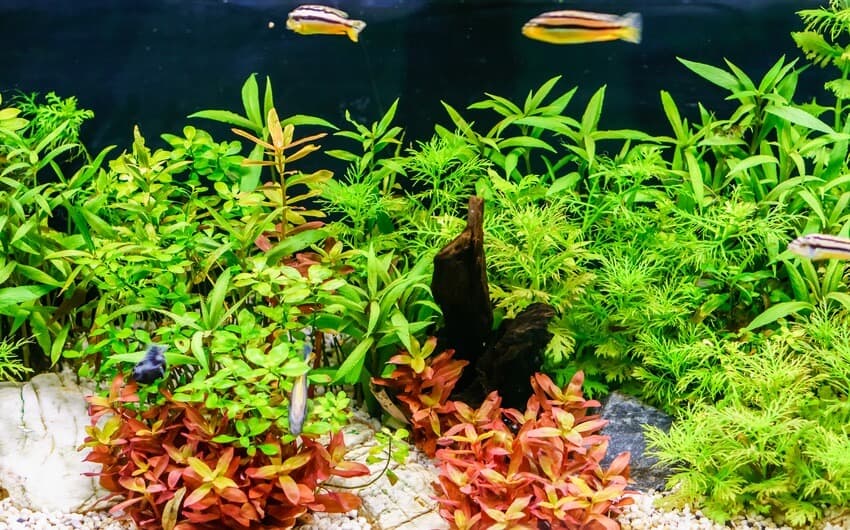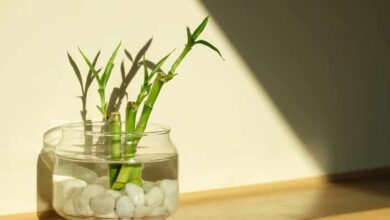Rotala Indica: The Complete Care Guide

Rotala indica is a beautiful plant that fits perfectly into many aquariums. It’s easy on the eyes, easy to maintain, and beneficial to the health of your tank.
This guide will teach you everything you need to know about Rotala indica care. This is a plant that you will definitely want to consider buying!
Species Summary
Rotala indica is a beautiful background plant that many aquarists use to anchor their décor. It is part of the Lythraceae family of plants and goes by many unique nicknames. You may see it called the «Indian Toothcup» which is the most common.

This plant is native to India and Southeast Asia. It is amphibian by nature, growing along rice paddies and riverbanks. Plants can grow submerged and extend above the surface of the water. In the wild, they also grow on land in ultra-humid soils.
The vertically oriented growth pattern makes the plant a welcome choice for background decoration. However, the thin, brittle blades also add tons of versatility. Whether grown singly or in dense groups, the Rotala indica plant is a sight to behold.
The benefits of having it in your tank
Beyond the obvious aesthetic benefits, Rotala indica can do a lot to improve the conditions in your freshwater tank.
Like any other living plant, Rotala indica uses nutrients in the water to flourish. The plant absorbs carbon dioxide and transforms it into usable oxygen. That oxygen disperses into the surrounding water.
Not only that, but the plant can help remove some of the most harmful contaminants that come from fish waste.
In general, it enriches the underwater environment and plays a crucial role in maintaining healthy water conditions. Your fish and aquarium inhabitants will earn the most.
Author’s note: But they will not only enjoy the best water conditions. Rotala indica can improve the quality of life of your fish. The long, flowing stems provide a dense forest of greenery for shy creatures to hide in.
The plant offers a wonderful form of shelter that can make your fish feel safe and at ease.
Appearance
Rotala indica is a dense plant that focuses on verticality.
It features tall, fleshy stems that continue to rise towards the light. As the plant matures, brittle leaves sprout from the stem and grow horizontally. In most cases, the leaves are round and concave.
However, some varieties also have grass-like leaves that are long and somewhat pointed.
Either way, these leaves are very delicate. They grow in small groups on both sides of the stem, resulting in a dense clump of vegetation.
The plant will change color a little depending on the growing conditions. It may remain completely green or develop pinkish-red flecks towards the top of the stem.
Author’s Note: If you’re lucky, you might see a pink flower bloom at the top of the stem. This happens quite often in nature. However, this is a rare event in a freshwater aquarium.
size and growth rate
When it comes to growth rate, Rotala indica plants are moderately fast. They can go off quickly in the right conditions. However, adjusting the environment will keep the plant relatively stocky if you prefer a stockier look.
The Rotala indica is usually sold in nurseries and pet stores when it is only a few inches tall. However, it can flower and climb to over a foot in height in no time. In larger tanks and ponds, this plant can get up to about two feet tall!
This plant can and will outgrow your aquarium if you are not careful. They require regular trimming to stay manageable (more on that later).
Care Rotala Indica
Rotala indica care is something most aquarists should have no problem doing. It is a beginner-friendly plant that easily adapts to most environments without issue. For this reason, it is one of the most popular aquatic plants for aquariums.
As always, there are some established care guidelines that you must follow. The Rotala indica plant has its preferences like any other variety. Fortunately, those needs are not too difficult to meet.
tank size
To ensure that water conditions remain stable, we recommend growing Rotala indica plants in an aquarium that is no smaller than 10 gallons. If possible, opt for a tank that is even bigger!
This plant shines brightest when found in large aquariums. They can bloom in the background and spread out to create impressive density.
Author’s Note: Smaller aquariums are not suitable for Rotala indica. This particular cultivar would just clutter the space. Also, the confined space would require constant trimming.
water parameters
Rotala indica plants do well in a wide range of freshwater environments. They are quite adaptable and surprisingly hardy. As long as you have standard tropical conditions they should work just fine.
That’s one of the reasons aquarists enjoy Rotala indica so much. They are a relatively hands-off plant when it comes to water conditions. As a result, you can focus on the most sensitive plant and animal life in your tank.
- Water temperature: 72°F to 82°F
- pH levels: 6.0 to 7.5
- Water hardness: 3 to 8 KH
Be sure to test your water parameters regularly (make sure you get an accurate test kit). Keep conditions within the ranges covered above and make sure the plant does not cause major fluctuations that could harm your fish.
Turning on
As with water parameters, Rotala indica plants are flexible when it comes to lighting.
They still need plenty of light on a standard day/night cycle, but you can choose how much light you provide based on your desired growth.

Less light exposure will keep the plant more compact. It won’t climb to the surface as quickly, which can do wonders for reducing clipping. Also, the leaves get bigger to capture as much light as possible.
At the opposite end of the spectrum, high light exposure increases growth rate. The plant will shoot up and continually develop more leaves.
Author’s Note: You may also witness a color change. More light tends to turn the stem tips and leaves red.
Substratum
Rotala indica plants require a fine substrate material. Sand works fine. However, the special substrate for aquatic plants is even better.
Plant-Focused Substrate looks like fine sand, but is infused with minerals and nutrients to stimulate growth. Think of it as potting soil for your freshwater aquarium!
With a good amount of fertilizer, Rotala indica plants will thrive. The plant will experience a growth boom. Plus, you’ll see that subtle hint of red coloration we mentioned earlier.
Author’s Note: For best results, provide a layer of substrate that is at least two inches deep. Two inches is perfect for letting the roots spread out and anchoring the plant.
How to plant Rotala Indica
Planting Rotala indica is a simple process. However, it can be a bit tricky given the verticality of the plant.
Aquarists typically purchase young plants that are about six inches tall. The root system is quite fragile and sparse. They do not have the extensive network of tendrils to keep the plant down.
Clean up dying bits and prepare a stain on the substrate. Then use long tweezers to carefully embed the bottom of the stem into the substrate material. Do it at a slight angle so that the substrate puts some weight on the stem.
Planting straight up and down doesn’t offer much grip. The plant will easily detach and float to the surface.
Author’s Note: It takes a bit of trial and error, but take your time and do your best to anchor the plant. We recommend giving your plant some time to develop new roots before adding fish that could accidentally dislodge it.
Trimming and pruning
Trimming is one of the most important parts of Rotala indica care, because preventing overgrowth is essential.
How often you will bring out the pruning shears will depend on the rate of growth. As we mentioned earlier, the amount of light and fertilizer you use will have a significant impact on the growth of the plant.
Author’s Note: Regardless of the growth pattern, you can cut back the plant whenever it becomes unruly. Some aquarists like to wait until it gets close to the surface of the water. Others will allow you to grow beyond the confines of the tank! Up to you!
To trim the back of the Rotala indica plant, simply use scissors to cut off the top of the stem. Cut just above a node where two leaves emerge.
Be careful with pruning and be sure to clean up any debris. The leftovers will dirty the aquarium or give way for a new plant to grow.
tank mates
Rotala indica plants do best with more docile, easy-going fish.
While many aquarists gravitate toward active swimmers putting on a show, these species can ruin Rotala indica! The leaves are too delicate for energetic inhabitants!
It is also important to avoid known rootless. This plant already has difficulty staying anchored when it is young. The last thing you want is to pair it with a fish that is constantly dislodging roots from the substrate.
Stick to the slow moving fish. Flowing-finned species work very well. The same goes for the smaller species that will not cause any harm.
Here are some good Rotala indica tankmates you can choose from:
- fancy goldfish
- Angelfish
- guppy fish
- molly fish
- Small tetras (such as the pristella)
- most freshwater shrimp
- Snails suitable for aquariums
How to spread it
Occasionally, Rotala indica will scatter seeds and reproduce naturally. However, this is rare in an aquarium.
The easiest way to spread plant growth is through propagation. Propagating Rotala indica is very easy. You can even do it after pruning and trimming!
All you have to do is cut off at least an inch of stem. Cut the original plant above a growth node and remove the leaves. Then plant it in the ground.
The freshly cut stem should begin to develop roots and become a new plant.
Ending
Rotala indica care can be done by anyone, no matter how experienced they are. That’s why it’s such a popular aquarium plant and why we recommend it so often!
If you have the right tank mates, we highly recommend giving this plant a try. The difference it can make is incredible.




